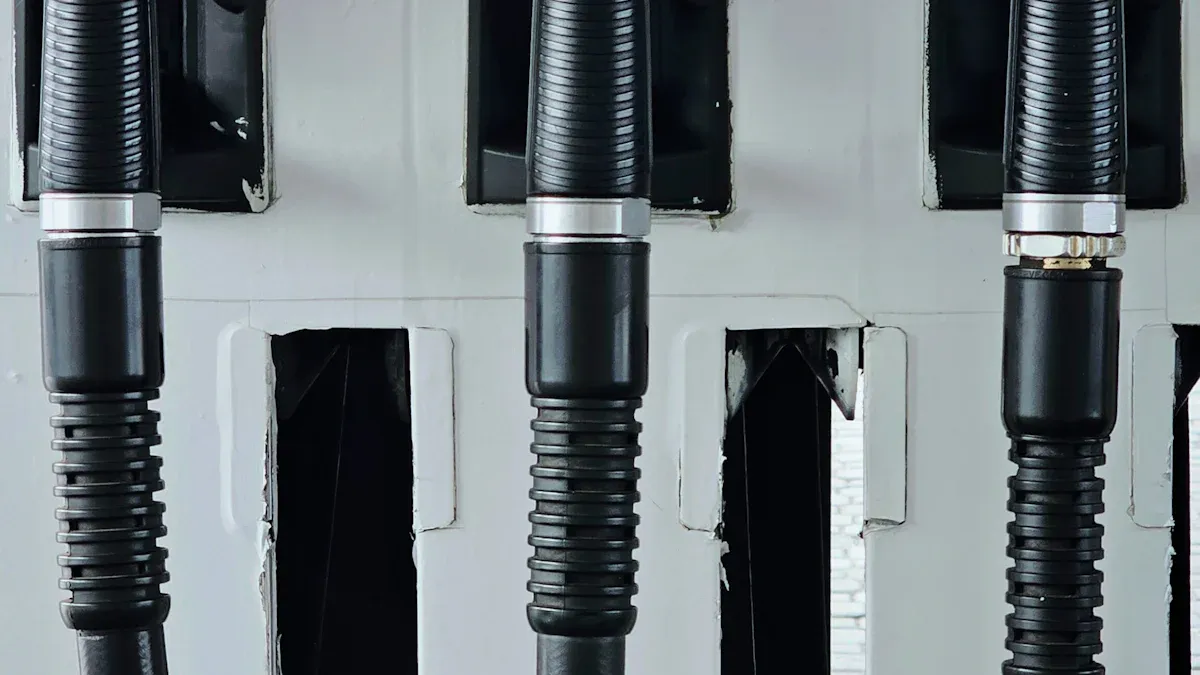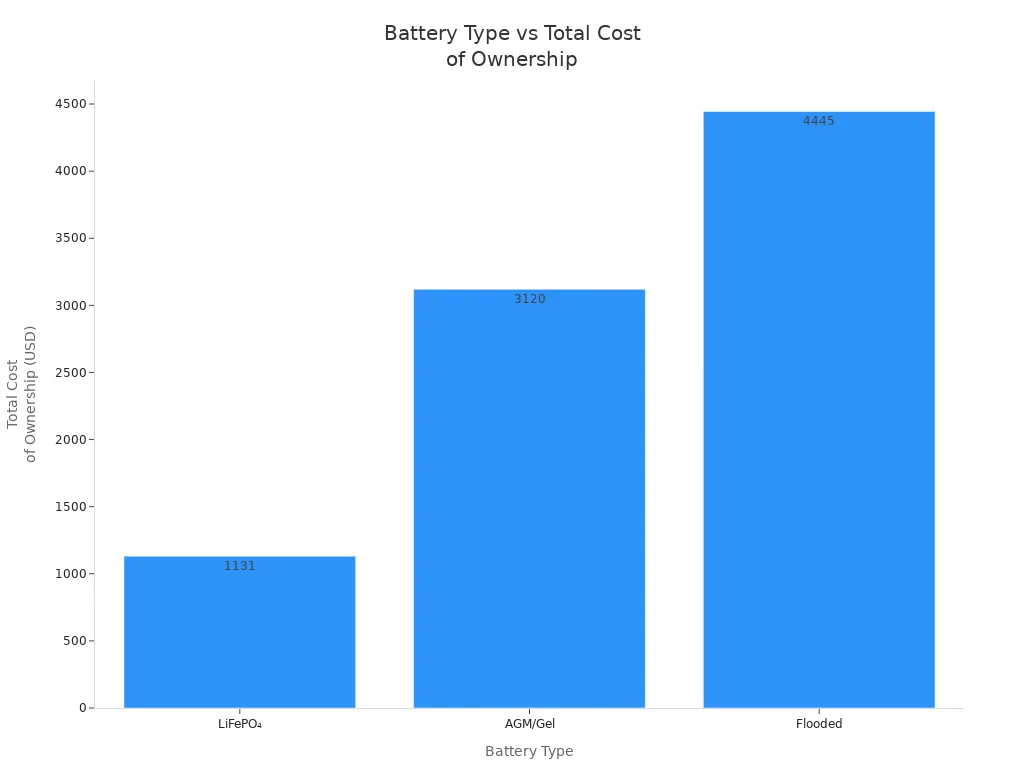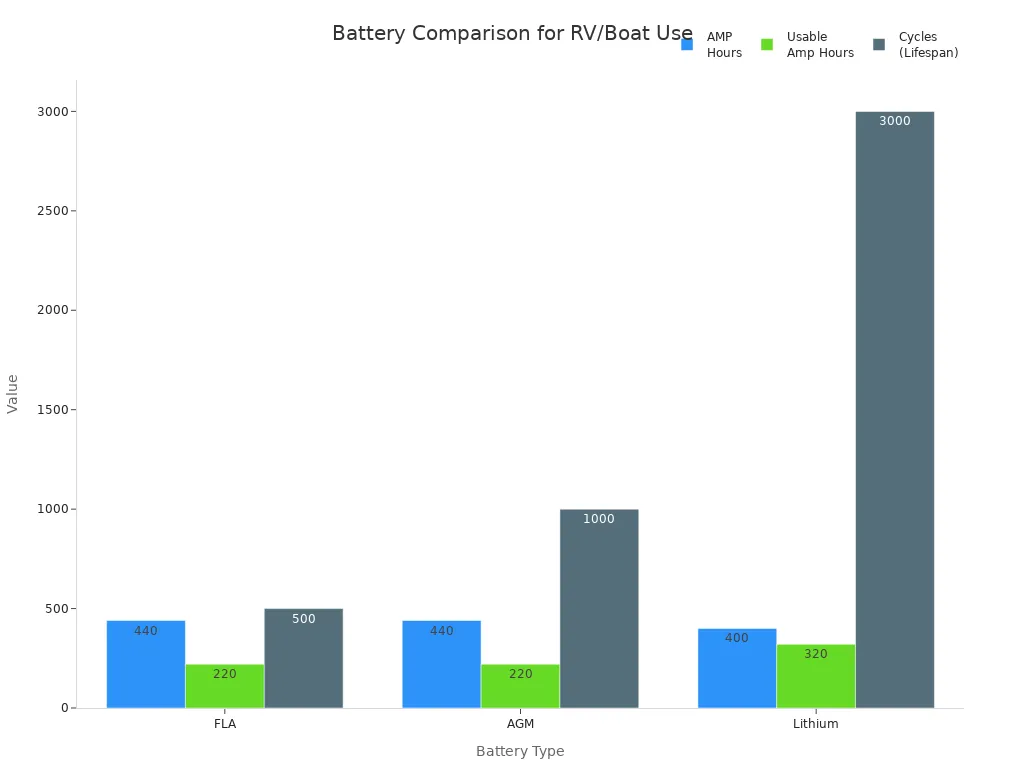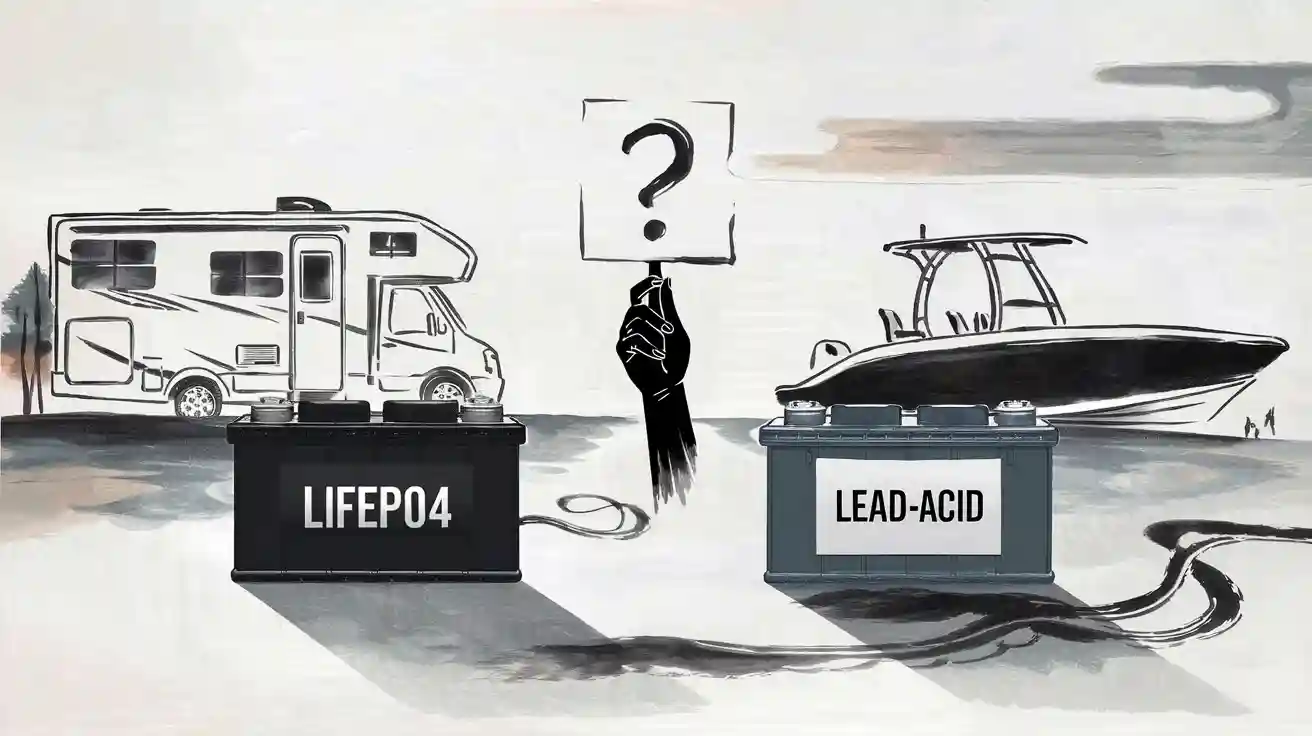Choosing Between LiFePO4 and Lead-Acid Batteries for RVs and Boats
When you choose a battery for your rv or marine adventure, you want the best balance of weight, lifespan, safety, maintenance, and cost. Most users today find LiFePO4 battery Advantages compelling because these batteries deliver longer service life, lighter weight, and minimal maintenance. However, lead-acid batteries still offer accessible pricing and remain a common choice. Adoption of LiFePO4 batteries in rv and marine settings grows by 8–10% each year, driven by their lower safety risks and reliability.
Here is a quick guide to help you compare:
Attribute LiFePO4 Lead-Acid Lifespan 5 to 8 years 3 to 5 years Weight Approximately 3x more power Heavier for the same power Cost $300-$1000+ $100-$200 Maintenance No maintenance required Requires regular checking Safety Low hazard, non-toxic Hazardous if damaged
With this essential guide to lifepo4, you can confidently compare both options and select the right battery for your needs.
Key Takeaways
- LiFePO4 batteries last longer, with a lifespan of 5 to 10 years, compared to 3 to 5 years for lead-acid batteries.
- Choose LiFePO4 for lighter weight and higher energy density, making installation and handling easier.
- LiFePO4 batteries require no maintenance, while lead-acid batteries need regular water checks and care.
- Consider your usage: LiFePO4 is ideal for frequent travelers and high-power needs, while lead-acid suits occasional users on a budget.
- Evaluate long-term costs: LiFePO4 batteries may have a higher upfront cost but save money over time due to fewer replacements.
Quick Comparison

Summary Table
When you compare LiFePO4 and lead-acid batteries for your RV or marine setup, you need to look at the features that matter most. The following table highlights the differences in performance, safety, and practicality. This overview helps you see which battery type aligns with your needs.
| Feature | LiFePO4 Batteries | Lead-Acid Batteries |
|---|---|---|
| Weight | Lighter, easier to handle and install | Heavier, more difficult to move |
| Energy Density | Higher, stores more energy in less space | Lower, bulkier for the same energy |
| Lifespan | 5–10 years (3,000–5,000 cycles) | 1–5 years (300–500 cycles) |
| Safety | Excellent thermal stability, low risk of fire | Can overheat, risk of toxic gas release |
| Cost | Higher upfront, lower long-term | Lower upfront, higher replacement costs |
| Maintenance | No regular maintenance needed | Needs regular checks and water top-ups |
| Depth of Discharge | 80–100% usable capacity | 50% usable capacity |
| Charging Speed | Up to 5x faster | Slower |
| Installation | Compact, fits tight spaces | Bulky, less flexible for installation |
Tip: If you want a battery that lasts longer, weighs less, and needs less attention, LiFePO4 stands out as the modern choice.
Direct Recommendation
You want a battery that matches your travel style and power needs. For most RV and marine users, LiFePO4 batteries offer clear advantages. You get a lighter battery that stores more energy and lasts much longer. You also avoid the hassle of regular maintenance and enjoy faster charging. Although the initial price is higher, you save money over time because you replace the battery less often.
Industry experts recommend LiFePO4 batteries for users who value reliability, safety, and long-term savings. If you travel often, rely on off-grid power, or want to minimize maintenance, you will benefit most from LiFePO4 technology. Lead-acid batteries still work well if you have a tight budget or only use your RV or boat occasionally. However, you should expect more frequent replacements and regular upkeep.
? Note: If you have questions about lithium battery charging or want to explore partnership opportunities, reach out through our website. Our team can help you choose the best solution for your needs.
LiFePO4 Battery Advantages
Weight and Portability
When you upgrade your RV or boat with a LiFePO4 battery, you immediately notice the difference in weight and portability. A 12V 100Ah LiFePO4 battery weighs only 10.5 kg, which is nearly two-thirds lighter than a comparable lead-acid battery. This lighter weight makes installation and handling much easier, especially in tight spaces. You can move and position your battery without special equipment or extra help. The high energy density of LiFePO4 means you get more power in a smaller, lighter package. This advantage is especially important if you want to maximize storage or reduce overall vehicle weight.
- High energy density allows for significant capacity at a lower weight.
- Easier transport and installation for all users.
- Compact size fits into more locations on your RV or boat.
Energy Density
LiFePO4 batteries deliver more energy per kilogram than traditional options. You benefit from an energy density that ranges from 90 to 160 watt-hours per kilogram. In comparison, lead-acid batteries offer only 35 to 50 watt-hours per kilogram. This means you can store more usable energy without increasing the size or weight of your battery bank.
| Battery Type | Energy Density (Wh/kg) |
|---|---|
| LiFePO4 | 90-160 |
| Lead-Acid | 35-50 |
With this higher energy density, you can power more devices and enjoy longer trips without worrying about running out of energy. This is one of the key lifepo4 battery advantages for anyone who values efficiency and performance.
Lifespan and Durability
You want a battery that lasts for years and stands up to tough conditions. Lifepo4 battery advantages include a much longer lifespan and greater durability compared to lead-acid. A deep cycle lithium battery can last more than 2,000 full charge and discharge cycles at 100% depth of discharge. If you use partial discharges, you can reach up to 8,500 cycles. In everyday use, lifepo4 batteries often last 10 to 15 years, while lead-acid batteries typically last only a few years.
- LiFePO4 batteries resist damage from deep discharges.
- They have low self-discharge rates, so you can leave them unused for months without losing capacity.
- Built-in Battery Management Systems (BMS) protect your investment and enhance safety.
These lifepo4 battery advantages give you peace of mind, knowing your power system will remain reliable and efficient for many years. The durability of lifepo4 technology means fewer replacements and less maintenance, making it a smart choice for RV and marine applications.
Lead-Acid Battery Features
Cost and Accessibility
You often see lead-acid battery options in RV and marine stores because they remain the most accessible choice for many owners. You can find these batteries almost anywhere, which makes replacement or upgrades simple during your travels. The price point appeals to budget-conscious users. Most lead-acid batteries cost between $100 and $300, while a comparable lifepo4 battery can range from $400 to $1,000 or more. This lower upfront cost allows you to equip your RV or boat with deep cycle batteries without a significant investment.
- Good performance in a wide range of conditions
- Widespread availability in most regions
- Reasonable price for most budgets
- High specific power for starting and running equipment
- Reliable operation in both low and high temperatures
You get a battery that delivers solid value and meets the needs of occasional or seasonal users. Lead-acid batteries also offer relatively safe operation when handled correctly, and their low self-discharge rate means you can store them for months with minimal power loss.
? Tip: If you need a quick replacement or want to keep costs down, lead-acid battery options remain a practical solution.
Maintenance Needs
You must pay attention to maintenance when you choose a lead-acid battery for your RV or boat. Unlike lifepo4, lead-acid batteries require regular checks to ensure safe and efficient operation. You need to inspect the water level every month, especially during periods of heavy use. Always make sure the water covers the plates, but avoid overfilling to prevent acid spills. Use only distilled water, never acid, when topping up the cells. If the plates become exposed, add just enough water to cover them before charging. After charging, adjust the water level to about 1/8 inch below the vent well.
- Check water levels monthly and top up as needed
- Add distilled water only, never acid
- Adjust water after charging to the correct level
Some lead-acid battery models offer maintenance-free operation, but most standard types require hands-on care. If you prefer a maintenance-free operation, you may want to consider lifepo4 instead. Regular maintenance helps extend the life of your lead-acid battery, but you should expect to replace it after 500 to 1,000 cycles, which is less than the lifespan of lifepo4.
Safety and Thermal Stability
Lithium Iron Phosphate Batteries Safety
When you choose lithium iron phosphate batteries for your RV or boat, you gain a significant safety advantage. These batteries offer a stable chemistry that resists overheating and combustion. You can rely on lifepo4 to perform safely, even in demanding environments. The table below highlights the built-in safety features that set lifepo4 apart from other battery types:
| Safety Feature | Description |
|---|---|
| Chemical Stability | Stable cathode reduces reactivity and combustion risk. |
| Thermal Resistance | Withstands high temperatures (up to 350-400°C) without breaking down, lowering thermal runaway risk. |
| Overcharge Tolerance | Handles overcharging without immediate damage, improving safety during use. |
| Physical Stress Resistance | Rarely catches fire when punctured or crushed, unlike other lithium-ion batteries. |
You can install a lifepo4 battery with confidence, knowing it will not easily overheat or catch fire. The robust design of lifepo4 also means you face fewer risks from accidental damage or improper charging. These qualities make lifepo4 a top choice for safety-conscious RV and marine users.
? Tip: Lifepo4 batteries provide peace of mind for families and frequent travelers who want the safest power solution.
Lead-Acid Battery Risks
Lead-acid batteries present several safety concerns you must consider. Improper handling or charging can expose you to electrical, chemical, and thermal hazards. The following tables outline the most common risks:
| Risk Type | Description |
|---|---|
| Electrical hazards | Can cause electric shock, short circuits, and fires if not properly handled. |
| Risk Type | Description |
|---|---|
| Chemical hazards | Chemicals can cause burns, respiratory issues, and environmental damage. |
| Risk Type | Description |
|---|---|
| Thermal hazards | Overcharging leads to gassing, releasing flammable gases that may cause explosions. |
You must regularly inspect and maintain lead-acid batteries to reduce these risks. Always use protective gear and follow manufacturer guidelines. Lifepo4 batteries eliminate many of these dangers, making them a safer alternative for your RV or boat.
⚠️ Note: If you have questions about battery safety or want expert advice on lifepo4 battery installation, contact our team for support.
Charging and Efficiency
Fast Charging (LiFePO4)
You want to spend less time waiting and more time enjoying your RV or boat. LiFePO4 batteries give you a clear advantage with fast charging. You can safely charge a 100Ah LiFePO4 battery at up to 100A, which means a full charge in about one hour. Lead-acid batteries cannot match this speed. They require much lower charging currents, usually no more than 20A for a 100Ah battery. Charging a lead-acid battery often takes several hours, especially if you want to avoid damage.
| Battery Type | Charging Efficiency & Speed |
|---|---|
| LiFePO4 | High (Fast Charging) |
| Lead-Acid | Low (Slow Charging) |
- LiFePO4 batteries support fast charging with a discharge efficiency of over 90%.
- Lead-acid batteries charge more slowly with an efficiency of around 70-80%.
- LiFePO4 batteries can be charged at rates up to 1C, while lead-acid batteries are limited to about 0.2C.
⚡ Tip: If you want to minimize charging time and get back on the road or water quickly, LiFePO4 is the best choice.
Efficiency Comparison
You need a battery system that delivers reliable energy efficiency. LiFePO4 batteries stand out with their high efficiency, often exceeding 90%. This means you get more usable power from every charge. Lead-acid batteries, on the other hand, lose more energy during charging and discharging. Their efficiency usually ranges from 70% to 80%. Over time, this difference adds up, especially if you rely on solar panels or generators.
LiFePO4 batteries also maintain their efficiency across a wide range of charge levels. You can use almost the entire capacity without harming the battery. Lead-acid batteries lose efficiency as they discharge and should not go below 50% capacity to avoid damage. This limits your usable energy and increases the number of charging cycles.
? Note: Choosing a lifepo4 battery means you get more power, less waste, and longer-lasting performance for your RV or boat.
If you have questions about charging or want to learn more about energy efficiency, reach out to our team. We are ready to help you find the best solution for your needs.
Performance in Different Conditions

Cold Weather
You need a battery that delivers reliable performance when temperatures drop. LiFePO4 batteries maintain strong performance in cold weather, even down to -20°C (-4°F). At -10°C (14°F), you still get about 80% of the rated capacity. This means you can trust your power supply for winter camping or boating. Lead-acid batteries, while able to operate in lower temperatures, often struggle with performance. Their capacity drops sharply, and charging becomes less efficient. You may notice your lights dimming or your appliances running for shorter periods.
When temperatures fall, the electrochemical reactions inside LiFePO4 batteries slow down. This increases internal resistance and reduces power delivery. Charging also takes longer, and the battery may not distribute lithium ions evenly. Over time, this can affect battery life. Despite these challenges, LiFePO4 batteries still outperform lead-acid batteries in cold conditions. You get more consistent performance and fewer worries about sudden power loss.
❄️ Tip: For winter adventures, choose a battery with proven cold-weather performance. If you have questions about optimizing your setup, our team can help.
Hot Climate
High temperatures create a different set of challenges for battery performance. LiFePO4 batteries excel in both high-heat and freezing conditions. You avoid common issues like voltage drops and overheating that can affect other battery types. Lead-acid batteries, on the other hand, lose about 50% of their lifespan for every 15°F increase above 77°F. This means your battery may need replacement much sooner if you travel in hot climates.
- LiFePO4 batteries maintain stable performance and durability in extreme heat.
- Lead-acid batteries experience rapid capacity loss and shorter service life.
- High temperatures can reduce charging and discharging efficiency for both battery types.
- LiFePO4 batteries, while more stable, can still face thermal runaway in extreme heat.
You want a battery that keeps your RV or boat running smoothly, no matter the weather. LiFePO4 batteries deliver superior performance in hot climates, giving you peace of mind during summer trips. If you want to learn more about battery performance or need advice for your specific environment, reach out to our experts.
Environmental Impact
Recycling
You want a battery that supports responsible recycling. Lead-acid batteries have a long history of recycling, with established systems in place worldwide. Most recycling centers accept these batteries, and the process recovers up to 95% of the lead for reuse. However, handling and recycling lead requires strict safety measures because lead is toxic and can harm the environment if not managed properly.
LiFePO4 batteries use materials like lithium, iron, and phosphate, which are less hazardous than lead. Recycling methods for LiFePO4 batteries continue to improve. Newer processes use less energy and create fewer emissions. Although recycling infrastructure for lithium batteries is still growing, you see more facilities accepting LiFePO4 batteries each year. This trend helps reduce waste and supports a cleaner environment.
♻️ Tip: Always recycle your used batteries at certified centers. Proper recycling protects the environment and keeps harmful materials out of landfills.
Eco-Friendly Aspects
You care about the environmental footprint of your battery choice. LiFePO4 batteries offer several eco-friendly advantages. Their lifespan can reach up to 10 times longer than lead-acid batteries. This means you replace them less often, which reduces resource use and waste. The materials inside LiFePO4 batteries—lithium, iron, and phosphate—pose less risk to the environment compared to the toxic lead in traditional batteries.
Lead-acid batteries require frequent replacement and use hazardous materials. Improper disposal can contaminate soil and water. In contrast, LiFePO4 batteries help you lower your impact on the planet. Their evolving recycling methods use less energy, making the entire lifecycle more sustainable.
| Battery Type | Lifespan | Toxic Materials | Recycling Energy Use |
|---|---|---|---|
| LiFePO4 | 5–10 years | Low | Decreasing |
| Lead-Acid | 1–5 years | High (Lead) | High |
? Note: Choosing LiFePO4 batteries supports a cleaner, greener future for your RV or boat adventures. If you want to learn more about eco-friendly battery options or have questions about recycling, reach out to our team for expert advice.
Cost Over Time
Upfront vs Long-Term Value
When you compare battery options for your RV or boat, you notice a clear difference in upfront cost. Lead-acid batteries have a lower initial price, making them attractive if you want to save money right away. LiFePO4 batteries cost more at first, but they offer greater long-term value. The table below shows how these two battery types stack up:
| Battery Type | Initial Cost | Long-term Economic Benefits |
|---|---|---|
| Lead-Acid | Lower | Less economical over time |
| LiFePO4 | Higher | More economical over time |
You might feel tempted to choose lead-acid because of the lower price. However, you need to consider the total cost of ownership. Over a ten-year period, lead-acid batteries require frequent replacements. LiFePO4 batteries last much longer, so you only need to buy one during that same period. This difference has a big impact on your wallet.
| Battery Type | Lifespan (Cycles) | Replacements Needed Over 10 Years | Total Cost of Ownership |
|---|---|---|---|
| LiFePO₄ | 4,000 | 1 | $1,131 |
| AGM/Gel | 500 | 6-11 | $3,120 |
| Flooded | 300 | 6-11 | $4,445 |
- LiFePO4 batteries require only one replacement over 10 years, while lead-acid batteries need six to eleven.
- The total cost of ownership for LiFePO4 is $1,131, much lower than $3,120 for AGM and $4,445 for flooded lead-acid batteries.
- LiFePO4 batteries also deliver 95% charging efficiency, which helps you save on electricity costs.

You gain more value from a LiFePO4 battery because it lasts longer and needs less maintenance. The long-term value becomes clear when you add up the savings from fewer replacements and lower energy loss. If you want to maximize your investment and reduce hassle, LiFePO4 stands out as the smart choice for RV and marine power.
? Tip: If you want to discuss your specific needs or have questions about battery charging, reach out to our team. We are ready to help you find the best long-term value for your setup.
Choosing for Your Needs
Occasional Use
If you use your motorhome or boat only a few times each year, you need a battery that matches your lifestyle. Consider these factors before making a choice:
- Travel duration and frequency—think about how often you access shore power or charging stations.
- Your camping style—determine if you stay at powered sites or prefer off-grid locations.
- Climate—plan for the regions you visit, as temperature affects battery performance.
- Charging options—check if you have solar panels or generators available.
- Depth of discharge—use about 80-90% of your battery’s capacity to extend its life.
- Peak load management—make sure your battery can handle multiple devices at once.
- Battery weight and space—balance your power needs with available storage in your motorhome.
For occasional marine use, lead-acid batteries offer a cost-effective solution. They are easy to find and replace. If you want less maintenance and longer life, LiFePO4 batteries provide peace of mind, especially if you store your motorhome for long periods.
Full-Time Use
Full-time travel in motorhomes and boats demands a battery that delivers consistent power and reliability. You need to compare battery types based on usable capacity, depth of discharge, and lifespan.
| Battery Type | AMP Hours | Maximum Depth of Discharge | Usable Amp Hours | Cycles (Lifespan) |
|---|---|---|---|---|
| FLA | 440 | 50% | 220 | 500 |
| AGM | 440 | 50% | 220 | 1,000 |
| Lithium | 400 | 80%-90% | 320 | 3,000 |

- FLA batteries require regular water checks and terminal cleaning.
- AGM batteries need less maintenance but still require clean terminals.
- Lithium batteries need no water checks and offer the lowest maintenance.
Proper charging and discharging help maximize battery life. Lead-acid batteries should not go below 50% charge. Lithium batteries can handle deeper discharges, up to 80%, making them ideal for full-time motorhome or marine use.
High-Power vs Basic Needs
Your energy needs shape your battery choice. If you run high-power appliances in your motorhome, such as air conditioners or induction cooktops, you need a battery that can handle heavy loads.
- LiFePO4 batteries excel at high discharge rates and keep voltage stable during heavy use.
- They provide reliable power for demanding applications in motorhomes and boats.
- Lead-acid batteries have lower discharge rates and may lose voltage during peak demand.
- For basic camping needs, lead-acid batteries can suffice, but they struggle with large appliances or high starting currents.
? For high-power setups or frequent off-grid camping, LiFePO4 batteries deliver the performance and reliability you need. If you have questions about optimizing your battery system or want to discuss lithium battery charging, our team is ready to help.
Who Should Choose Which?
Best for LiFePO4 Battery
You should choose a LiFePO4 battery if you want the most advanced power solution for your RV or boat. This battery type fits users who demand high performance, long lifespan, and minimal maintenance. If you travel often, rely on off-grid power, or use energy-hungry appliances, LiFePO4 batteries deliver the reliability you need.
LiFePO4 batteries excel in situations where you need to run essential appliances like fridges, lights, and inverters for extended periods. Their lightweight design makes them easy to install and move, which is especially helpful in boats and camper vans with limited space. You also benefit from rapid charging, so you spend less time waiting and more time enjoying your journey.
Ideal scenarios for LiFePO4 batteries include:
- Full-time RV living or frequent travel
- Off-grid camping or boating with limited access to shore power
- Running high-power devices such as air conditioners, induction cooktops, or trolling motors
- Fishing boats and powerboats that require consistent, high power delivery
- Cruising sailboats where safety, long cycle life, and rapid charging matter
| Use Case | Why LiFePO4 Excels |
|---|---|
| Cruising Sailboats | Safe, lightweight, high capacity, rapid charging, long cycle life |
| Powerboats | Consistent high power, less weight, longer shelf life |
| Fishing Boats | Lightweight, long cycle life, ideal for long outings |
| Camper Vans | Supports 12V fridges, lights, inverters, fast alternator charging |
? Tip: If you want a battery that keeps up with your adventures and reduces long-term costs, LiFePO4 is your best choice. You can always reach out to our team for advice on lithium battery charging or system upgrades.
Best for Lead-Acid Battery
You should consider a lead-acid battery if you use your RV or boat occasionally and want to keep your initial investment low. Lead-acid batteries remain a practical choice for users who do not need high power output or long cycle life. If you camp at powered sites, take short trips, or only use basic appliances, lead-acid batteries can meet your needs without stretching your budget.
Lead-acid batteries are easy to find and replace. Many stores carry them, so you can get back on the road or water quickly if you need a replacement. They work well in moderate climates and provide reliable service when maintained properly.
Lead-acid batteries fit best when:
- You use your RV or boat a few times a year
- Your trips are short and you have regular access to shore power
- You run onl
-

 May.2025.11.24Ternary Lithium Battery vs Lithium-ion: Complete Comparison Guide (2025 Edition)Learn More
May.2025.11.24Ternary Lithium Battery vs Lithium-ion: Complete Comparison Guide (2025 Edition)Learn More -

 May.2025.11.214S2P 18650 14.8V Battery: Complete Technical Guide, Specs, Applications & SafetyLearn More
May.2025.11.214S2P 18650 14.8V Battery: Complete Technical Guide, Specs, Applications & SafetyLearn More -

 May.2025.11.18PCM vs BMS in Lithium Batteries: What’s the Difference and Which One Do You Need?Learn More
May.2025.11.18PCM vs BMS in Lithium Batteries: What’s the Difference and Which One Do You Need?Learn More -

 May.2025.11.17Custom Li-ion Battery Design for Medical Devices (2025 Comprehensive Guide)Learn More
May.2025.11.17Custom Li-ion Battery Design for Medical Devices (2025 Comprehensive Guide)Learn More -

 May.2025.11.17The Future of Lithium-Ion Batteries: Innovation, Sustainability, and Global Market TrendsLearn More
May.2025.11.17The Future of Lithium-Ion Batteries: Innovation, Sustainability, and Global Market TrendsLearn More
















